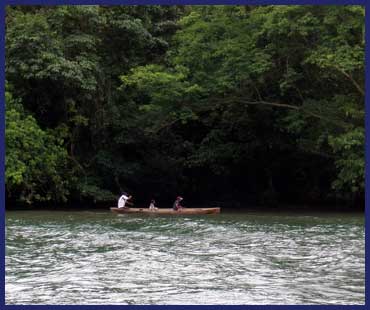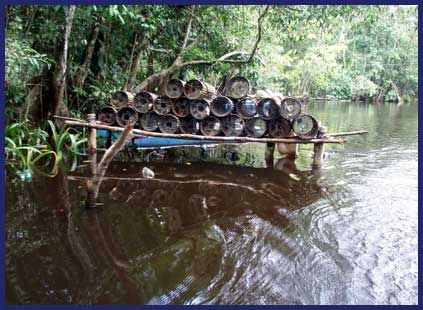+
|
We came for a few weeks on our way towards the USA and ended up staying for 4 months and then going to Guatemala instead. So we must have really liked the place a lot? Well no or at least not quite that much. It just proved to be an extraordinarily difficult place to leave, at least for us. We'll come to that, but first a bit about Belize. Formally, British Honduras and the only English speaking country in Central America it still retains a certain old fashioned Britishness. It's hard to put your finger on, it's not just the Queen's head on the banknotes, the coins they call shillings, the Heinz baked beans and marmite on the supermarket shelves, or the availability of brown ale in the bars, it's tiny things that pop up in use of language or manners that we recognise from our childhoods. |
||
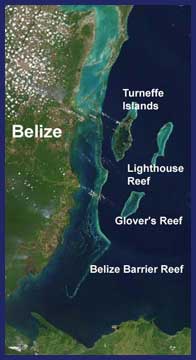 |
It's a small, poor country of 350
thousand inhabitants and virtually no natural resources. There's about 140
miles of coastline between the Guatemalan and Mexican borders with a large
handful of small islands and all protected by the second longest barrier reef
in the world,
without which the Belizean coast would be one long horrible lee shore on the
receiving end of 1,500 miles of seas piled up by the trade winds blowing the
length of the Caribbean. As
it is, although the country lacks anything approaching a natural harbour,
the seas inside the reef are generally flat and this, plus the trade winds,
make for easy sailing conditions, and this in turn has attracted in the large yacht
charter companies. Outside the barrier reef are also three significant
atoll reef systems with spectacular diving. Add to that
jungle, nature reserves and Mayan ruins - all in a country that is generally safe and
with inhabitants who are mostly charming. All that
sounds pretty good and certainly provides plenty of material for brochures
and advertisements, but somehow, at least for cruisers like us, the reality
seems to add to something less than the sum of it's parts. We arrived at Belize via the Ranguana Pass, one of a handful of entrances through the barrier reef and anchored for our first night at Ranguana Cay, a coral island of sand and palm trees, just like in the brochures. I say "anchored", but that should be in the plural. We had three goes at it and even after that we weren't very confident of the holding, but the forecast was benign and we had plenty of room if it all went pear-shaped in the night. The problem was that surrounding most of these lovely coral islands is just a very thin layer of sand and coral rubble over a rock bed, so nothing for the anchor to set into. Though if you're really lucky you can pick up your very own lump of coral in the anchor and spend the next half an hour finding innovative ways of removing it! The only way to find good holding, we were to discover, was to anchor behind the decidedly un-scenic and often mosquito rich mangrove islands which were surrounded for the most part by thick gooey mud. |
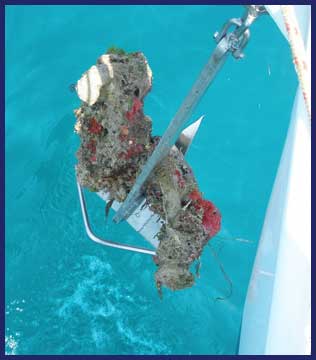 |
| But back to the charming Ranguana Cay with its sand and palms, at least we had those for an evening stroll. Well actually not or not unless we wanted to pay $10 each to step onto the beach. Like many of the nicest islands, Ranguana Cay had been sold and was now private. At least here you can go ashore - many of the other islands are private with a capital P and quite a few islands within the marine reserves, where one has to pay to anchor, are private and anchoring is prohibited. | ||
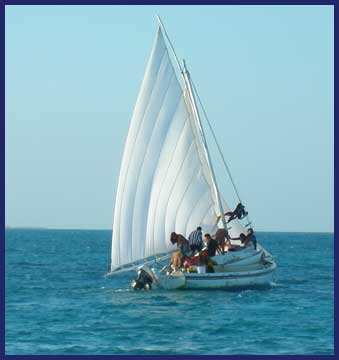 |
Anchor up the following morning, remove coral and head west. Placencia, the only place where a boat of our draught can sensibly clear-in (more of that later) was the ultimate destination, but the weather was forecast to deteriorate and the wind direction would make Placencia less than ideal (Belize doesn't actually have a single decent harbour) so we were making a detour 10 miles south to anchor behind the enticingly named "No Name Point". 18 miles as the crow flies, but more like 25 on the route we would need to follow in order to have deep enough water, The anchorage at No Name did offer great protection, surrounded from all directions by mangroves, anchored in thick mud, but with only about 50cm of water under our keel. Shallowness was something we were going to become (almost) accustomed to during our time in Belize and we'd also later have the opportunity to experience having no water under our keel, AKA being aground. The diversion to No Name turned out to be a good call for a number of reasons. We were in contact with Mark & Amanda on Balvenie anchored at Placencia and they were having a pretty torrid time. The bay was wide open to the southerly swell and the boat was rolling so badly they were having to sleep on the floor. Also, taking shelter at No Name were Roger and Carol on Androsian who were old Belize hands and knew all the best spots, so a couple of days later with the weather improving they led us to another sheltered anchorage only a mile from Placencia - just as bleak and even shallower with barely 20cm under the keel and not even distinguished enough to be named No Name. From here it was a longish dinghy ride to Big Creek, the banana loading port where Customs & Immigration were located. Roger and I set off to get the formalities out of the way, but it was not to be. Despite every conceivable form of arguing, cajoling, pleading, nothing would entice the security guards to allow us ashore. Instead we would have to re-anchor at Placencia, and from there catch the Hokey Pokey water taxi to Independence where we could then take a land taxi to the offices which were just 100 metres from where we were currently sitting in the dinghy. |
| So, next day to Placencia for a second attempt at the paper work. Apart from the slightly laborious process, all straightforward. Though it should be said with a fee of US$5 per person/per day just to be in the country (a number of anchorages are in National Parks and attract additional fees of $5 pp/night) and US$50 to extend ones stay after 30days - Belize probably has the most expensive clearance fees of any country we have visited. And, you can add to that at the public jetty in Placencia where you will be informed loudly that there is a $5 fee for each bag of rubbish taken ashore! In fact Belize is a pretty expensive country in every way you care to mention - it's difficult to comprehend sometimes how the locals survive! These fees together with the fact that, at least for deep draughted boats, this bureaucracy can only be completed in Placencia and has to be repeated every 30 days - cause many vessels on route from the US to Panamá to bypass Belize altogether. Considering that tourism is the country's largest employer and largest earner of foreign currency it's hard to understand why Belize appears to have worked so hard to discourage cruisers from visiting. | |
|
Enough of the rant. All that aside, Placencia is charming. Of course it's touristy (in a low key Belizean way) and it's not really representative of Belize, which is much more gritty, but we did like it, which is just as well as we were going to be coming back there very, very often. But we didn't know that then. Out to dinner with the Balvenies, now recovered from rolling. After that some serious shopping then off to explore all those picture postcard islands. It wouldn't be long though before we discovered that, in the same way that picture postcards manage not to include the eyesore right next door, not all those islands were quite what they seemed. First stop Wippari Cay. The island is now private and the two mooring buoys make it virtually impossible to anchor with sufficient shelter. Bugger! Off to Lagoon Cay, not as pretty, but not private and no mooring buoys, only a very narrow strip of sand to drop the hook in surrounded by really deep water. Still, better than nothing. We'd stay there for the night and move on in the morning. South Long Cocoa Cay - pretty, private and with much construction going on, but more importantly try as we might we could not get the anchor to bite in the hard bottom. Try another one. Cary Cay "excellent holding in sand" the pilot says and "nesting ospreys". We'll go there then. |
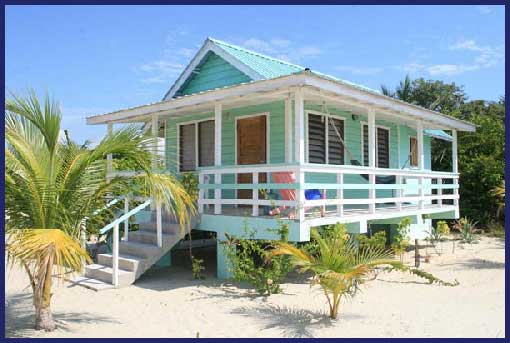 |
| Not much room, but we did find a bit of sand amongst a lot of coral. Not private, but not really possible to go ashore because the island is so heavily wooded. There were ospreys though. Now on the plus side there were beautiful islands which although private welcomed you ashore, but not many. There was also great snorkelling and dolphins and manatees and rays and nurse sharks, so you didn't feel the need to go ashore anyway, but one can't help feeling Belize must have been a lot nicer 20 years ago. | |
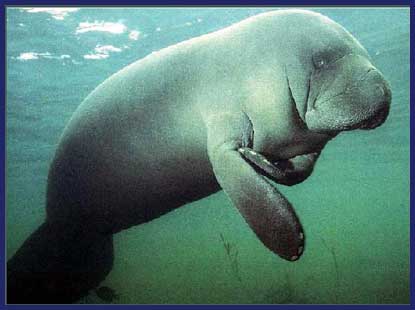 |
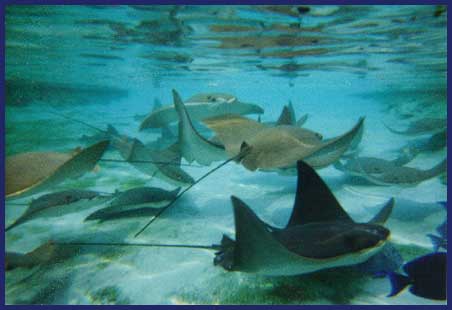 |
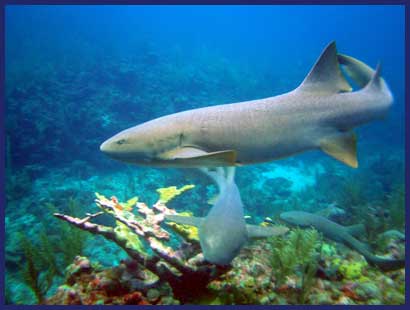 |
|
But for us Belize was really a pit stop on the way to Mexico, Cuba and all points north so after a month we returned to Placencia and cleared out for Mexico. Now, if you're not a sailor the next paragraph may have you glazing over and searching for the off button so feel free to skip down the page a bit. The problem with the trip north is that the coast runs NNE and the west setting current means that you have to steer closer to NE to lay your course. The prevailing wind is NE to ENE which means that's pretty hard to do. However, the good news is that every week to ten days the wind goes ESE for a day or two and although the window's quite short (it's generally followed by a strong northerly which is best avoided), the trip becomes do-able. But (always a but) if you're a shallow draughted boat, you can clear out close to the Belize, Mexico border and you've then got about 120 miles to the corner where the coast starts to turn north and/or there's decent shelter or 150 miles to a secure marina. If however your boat draws 2.1 metres (like Samarang) you can't get any further north inside the reef than Belize City and you have no real choice but to clear out in Placencia so your trip becomes 210 and 240 miles respectively and your draught also prevents you from getting into the best protection at that first bay. We cleared out and headed north for 3 days - towards the northernmost reef exit for us - with a promised weather window, but the window shrank as we approached it - High twenties gusting thirties overnight and going ENE was the message from Chris Parker (the man we pay to give us good weather advice). Bugger, that was our unanimous decision. No problem, we'll wait for the next one and we did, and for the next one and....... Well I'm sure you've guessed the rest. After 5 weeks of being cleared-out of Belize and not actually having left we really had no choice but to do the decent thing and clear back in. The authorities were probably not going to be too happy with us anyway. So with our tails between our legs we slunk back to Placencia. Heartbreaking to give up all the Northing, which would make it even harder to get away, but we really had little choice. Actually, Immigration and the harbour master weren't in the least interested and cleared us straight back in. Customs were a different manner. I was taken to be interviewed by the officer in charge. Lindy was sent away to be "spoken to later". "Where have you been? Why didn't you go here?" questions in rapid succession "Too shallow. Not a point of entry. Bad weather." were the repetitive answers. I think he was looking for contradictions. Then "why didn't you go to Majahual?" - "Never heard of it." I replied. "It's huge" he exclaims "It's a Mexican naval base and all the cruise ships go there." "Still never heard of it. I'm sure it's not in the pilot" I say. He breaks into a grin. I think he's found what he's looking for, a way out. I'm clearly not a smuggler. No smuggler would present at Customs with such a stupid story, but he's started the interrogation and he needs a way to finish it honourably. And now he has it. He's found something I don't know and he can send me away having helped me out and grateful. He hammers the keyboard and spins the PC to face me, an overhead photo of Majahual - it is indeed a cruise liner terminal with three liners moored. For us it would be an open roadstead and quite impossible. But more importantly, the interrogation now seems to be over and we're just two guys discussing the local geography. All smiles he leads me out and everything's fine. Lindy doesn't even get to have her finger nails pulled out!
|
||
|
By now we needed a serious revision of plans. Time was getting short for the trip to the US. We would be under real pressure to get far enough north before the hurricane season, which would curtail our time in Cuba. On the other hand we couldn't spend the hurricane season in Belize, even if we wanted to. But, the only other option was Guatemala and the Rio Dulce. Plusses were a big cruising community, loads of marinas, a couple of boatyards with the ability to lift us and do the work we planned for this summer and best of all, skilled labour at US$40 per DAY as opposed to $90 per HOUR in the US. The minor downside - the mile long river entrance is only about 1.6 metres deep and we draw 2.1. We knew it could be possible at high water springs, maybe with a tow, maybe with the boat careened. We knew lots of people who'd heard of people with our draught who'd done it. We'd never actually been able to speak to any of them, but.............. With the decision made we could relax and enjoy Belize - at least until we had to attempt the entrance across The Bar! Dic & Lizzie on Indian Summer, our neighbours from Santa Marta arrived in Placencia so we had a great excuse to wine and dine and spent three weeks sailing with them. After they left we settled into what became a kind of 2 week'ish natural circuit, starting and ending in Placencia for reprovisioning, then visiting our favourite snorkelling spots interspersed with our favourite anchorage for sheltering from bad weather (50 knots for 3 hours one night was the worst).
|
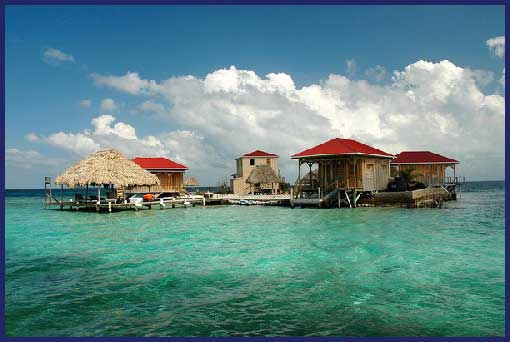 |
|
|
||
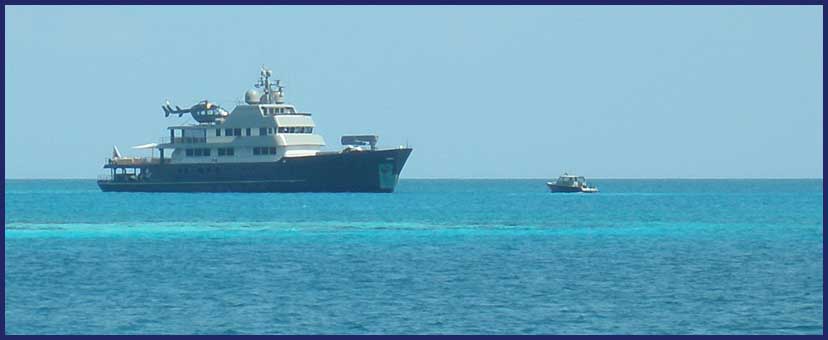 |
But finally it was time to leave (we had a
tide at High Water Springs to catch at the end of May).The plan was to spend the next week exploring the allegedly great
snorkelling around the southern islands in Belize, and then cross the
bar at the entrance to the Rio Dulce at Livingston on Monday with a 2.1
foot tide and a mate of local Mr Fixit Raul's on standby with big
fishing boat to do the necessary if we got stuck. (Actually slightly
higher on Sunday, but overtime and other complications.) Anyway, the weather didn't have the same agenda - squalls, squalls and more squalls was the forecast. We shelved the islands idea and decided to go more directly to Guatemala and headed off instead to New Haven. Great anchorage, but also great big biting yellow bug things and scenery that could have inspired The Wasteland. So motored off again the next morning to Tres Puntas in Guatemala where we thought we could hang around for a few days to wait for the highest tide to get into Livingston. A couple of boats we knew were already there, all with less draught than us, who would be crossing the bar on Friday morning to avoid the Monday morning rush hour. |
|
| We asked one of them, Ralph on Fortuitous, to check with Raul whether we could come in on Saturday instead, because of the bad weather, if we wished. Unfortunately, he asked him in front of the Port Captain, who now being alerted to our existence, was insistent that we must clear-in asap. Well asap was by now Saturday, and a squall had just come through putting wind in the southwest and us on a lee shore, making three days at Tres Puntas seem decidedly less attractive anyway, so we agreed we would meet Raul's mate at 07.15 at the sea buoy the following morning. | ||
|
Oh, nearly forgot to mention, Fortuitous, who had the
same 'way points' as us, told us that he only saw 6 feet on his
way over the bar, a foot less than our draft - bliss!! - and
that the boat that came in after them had to be careened for
nearly a mile - he was very late, on the wrong track, and his
boat was called Still Crazy - but not good for our confidence
levels. We hauled anchored and headed a few miles down the coast to Bahia
Graciosa to get shelter from the swell and have a relaxed time to
contemplate running aground on the bar the following day. And that was
all hunky dory until the next batch of squalls came through in the
middle of the night packing 40 knots - this time of course from the NE
(putting us on a lee shore once again). Not to worry, we needed to
be up early anyway and weren't really sleeping much 'cos of fretting
about the morning. So when the trivial 25 knot squall came through just
as we were hauling our anchor at 04.45 our happiness was almost
complete. |
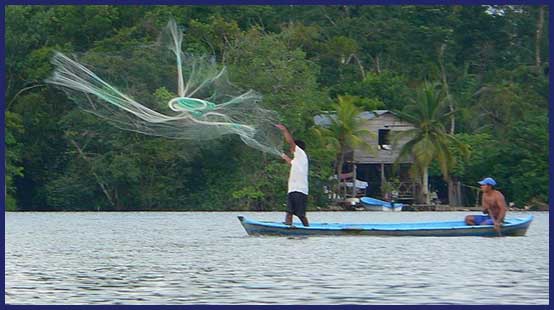 |
| We motored around the buoy for
twenty minutes, making VHF calls we knew weren't going to be
answered, whilst a French shallow draught ketch glided past us
on his way into Livingston. How long do we wait before we just
go for it on our own? - Is the big question?? Then I thought I could see something through the haze, something moving in the harbour. We keep peering and then, yes it was moving and it was a boat, but was it coming towards us? After an agonising 5 further minutes we were almost sure that it was creeping in our direction. Not as fast as the panga that overtook him heading straight for us though! The panga arrived. He wanted to be our guide. 7 foot draught would be no problem he insisted - as long, of course, as we had a good guide - "the channel is very narrow". We told him we were waiting for Hector & Gaviota. "Is that boat Gaviota?" He was a bit evasive, but finally confirmed that the vessel inching in our direction was indeed said Gaviota. Having exhausted all of his bargaining chips the panga man broke out into big smile - "You don't really need a guide or a tow." he said "Just head towards that small white house on the south shore and then turn towards the town dock." Now Hector rolls in (it is indeed very rolly). Profuse apologies for the delay and lots of smiles "All Raul's fault." This is probably not true, but now is not the time to start a long philosophical debate in Spanish about the meaning of truth. Panga man lights a cigarette and sits back to watch the fun. My suggestion is - we just go for it on our own, following him, and only start buggering around with lines if we grind to a halt. Hector looks unhappy. I reassure him that I'll pay him his $50 whatever happens, but he still looks unhappy. Hector is in fact, not only a really nice guy, but also a real pro and has done this more than a few times before. His suggestion is - that we connect the tow rope now - 'cos that'll be easier - and that he tows us from the beginning, because if we're tied to his stern we're bound to be on the right course and if we do touch bottom, he's got a big powerful engine which will keep on pulling us through. Better not to stop, better no lines to mast, better no heeling the boat over, etc, etc - Big smile! Lindy agrees. We go with his suggestion. And...... Well actually, it's a piece of piss! Best $50 we ever spent. Our engine idling in neutral, Hector doing all the work. ¡Muy, muy, muy tranquilo! We stood watching the depth gauge. It read 2.0 or 1.9 a handful of times, but only instantaneously when we're in the trough of a wave, mostly it's 2.2/2.3. We're absolutely sure we'd have got through on our own - as long as we'd been on the right track - and there's the rub! We had loads of tracks - too many - but the track he followed wasn't quite any of them. The closest was spookily not as one might expect the "new" track supplied by Raul, but actually the very "old" track in the Rauscher pilot. Interesting! Also, we had thought that the track might change quite frequently with the outflow of the river, but Hector confirmed that the channel was pretty much always in the same place. We didn't think to ask why the entrance buoy was somewhere else?? We, of course, now have that track and the question is - will we use Hector again when we leave? And the answer is - Absolutely Yes! A while later a lancha delivered the full house of officials accompanied by Raul to clear us into Guatemala. We sat in the cockpit for 10 minutes chatting... the quality of Guatemalan rum, the price of wine, bow thrusters - normal small talk - whilst immigration lady wrote our names in an exercise book, then they were gone. Pick up everything in an hour from Raul's office - Q1,400 ($182) - I think the easiest clearing-in we can remember. Back to the boat with veggies, beer and a new sim card in the rucksack. The anchorage has now become a horrible place - wind has built and is blowing straight into the bay, tide is now definitely flowing out and we're lying side-to everything and rolling like a pig with the anchor chain rubbing back along the hull. Time to go. |
|
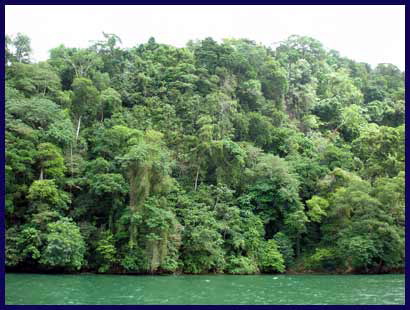 |
Just as everyone says, the gorge is spectacular. You wind your way between two vertical walls of green. The buzz of the insects was so loud, even over the engine, that we had to go below to check we hadn't inadvertently switched on the spin dryer! Halfway through we overtake a canoe who decides to show us that Perkins 4236 produces less power than two guys with paddles. They easily keep pace with us, even stopping to take swigs of cola, but after 30 minutes they've made their point and with smiles and waves, they drift off into the undergrowth.
|
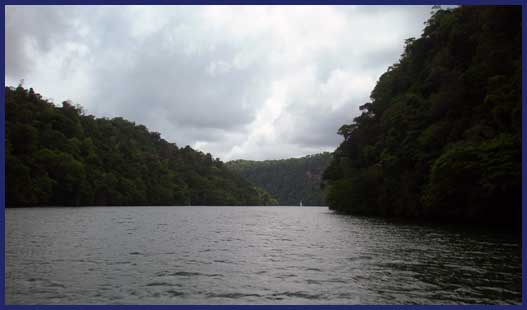 |
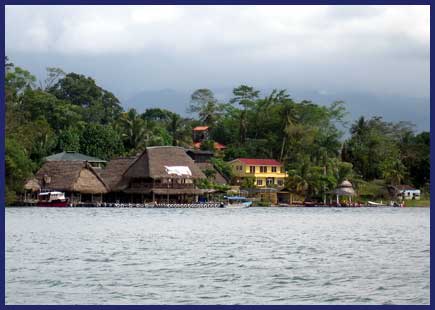 |
Finally, after a couple of hours we pop out into El Golfete, avoid what
is presumably the local Saturday afternoon gill net casting competition
- there are so many canoes casting nets it's hard to see how they don't
catch each other. We just want all the nets a long way from our prop!
Just a little later we're at anchor outside Texan Bay - which truly does
seem to be full of Texans. And then it's scrambled egg and beans on toast, collapse and to bed before 8pm. |
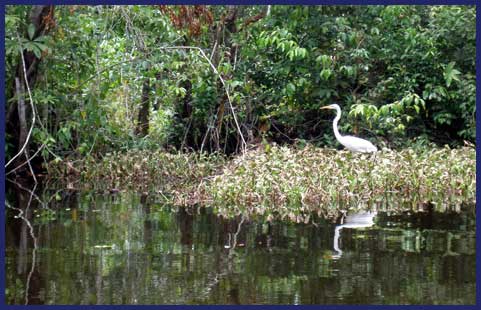 |
|
|
||

